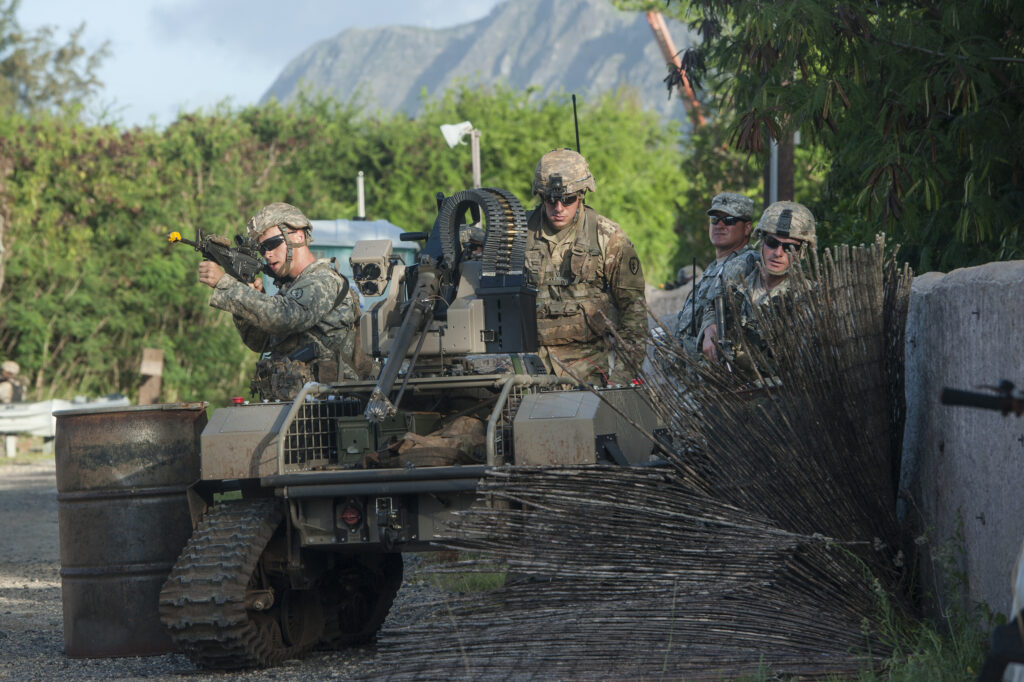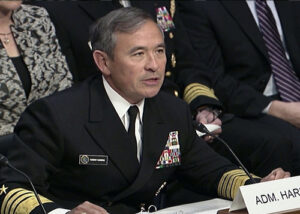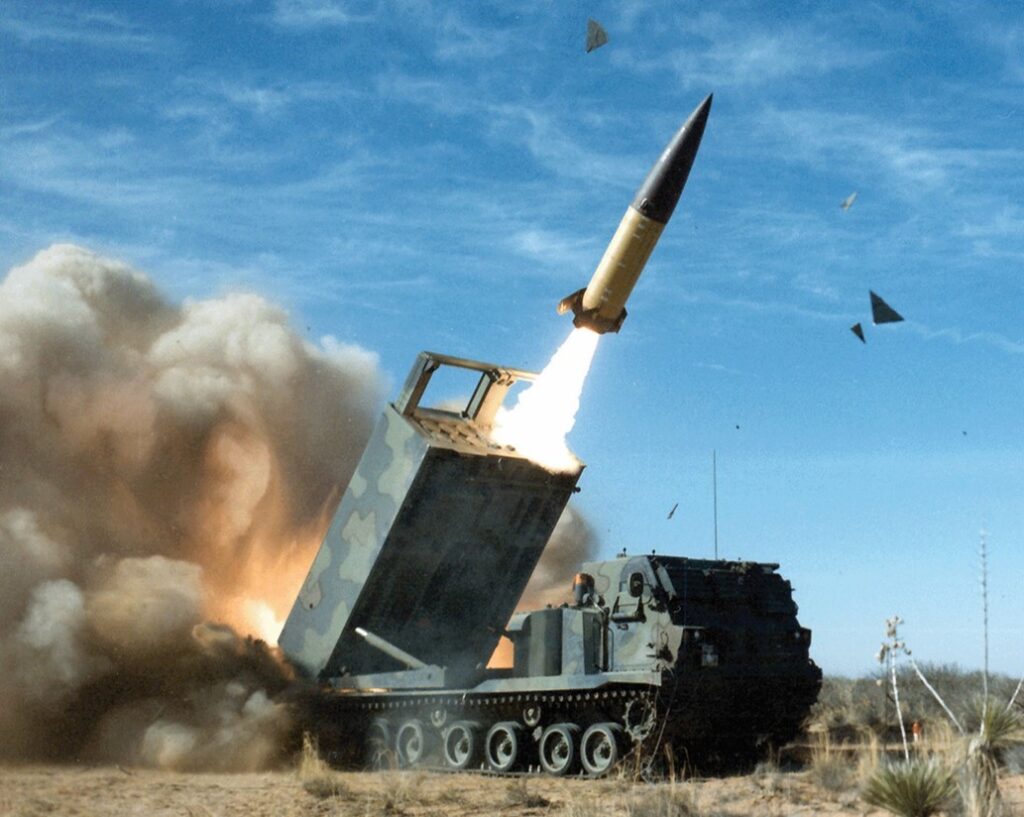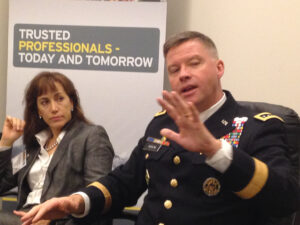Army’s Multi-Domain Battle To Be Tested In PACOM, EUCOM Wargames
Posted on

A soldier mans a robot-carried machinegun during the Army’s PACMAN-I experiment in Hawaii.
ARLINGTON: Harry Harris has to be the Army’s favorite admiral. The chief of Pacific Command has called for Army-owned anti-ship missiles. He has enthused over the Army’s new warfare concept, and now he is planning a major inter-service exercise to work out what that Multi-Domain Battle concept means in practice.

Adm. Harry Harris
“We are starting to put together these Multi-Domain exercises in the real domain — boots in the dirt, sailors on the ocean, etc.,” Gen. David Perkins said. He’s the occasionally insubordinate head of the Army’s powerful Training & Doctrine Command (TRADOC), which authored the concept.
PACOM will hold its wargame in early 2017, and European Command will hold a similar joint exercise in 2018, Perkins said. TRADOC observers are heading out to other wargames as well.
“We’re partnering with the geographic combatant commanders (because) in the end, they’re our customer,” Perkins told reporters after a talk to the Association of the US Army this morning. “I was out with Admiral Harris personally a couple of months ago; General McMaster and myself have spent time with them. (Lt. Gen. H.R. McMaster is Perkins’ highly regarded deputy). It’s a growth industry. TRADOC working with the COCOMs through the (regional) Army Service Component Commanders.”

Army ATACMS missile launch. The Pentagon now wants to upgrade ATACMS to sink ships.
Such inter-service outreach is a new tactic for TRADOC, traditionally an inward-focused bureaucracy prone to oracular pronouncements of doctrine. What’s still more striking is that the other services seem highly receptive to Multi-Domain Battle. That’s in stark contrast to the joint reception of the Army’s previous big idea, Strategic Landpower, which never quite gelled despite almost two years of talks where the Air Force and Navy were largely absent and the Marine Corps representatives looked like they’d rather be anywhere else.
This time, the Army’s struck a chord that resonates. Multi-Domain Battle, starting with its very name, calls for the four armed services to work more closely together than ever before in all domains: land, sea, air, space, cyberspace, and (unofficially, for now) the electromagnetic spectrum.

Janine Davidson and Gen. David Perkins at AUSA.
“H.R. McMaster and Gen. Perkins have done great work, heavy thinking about the future nature of conflict,” said Navy Undersecretary Janine Davidson. “We have thought about the joint fight at the operational level for a long time, and we have worked hard on it, but what is new about Multi-Domain Battle is the focus on the domains.”
“When Goldwater-Nichols was written (in 1986), cyber and space were not part of the game, not how they are now,” Davidson told me. “Back then, ‘Joint’ was about cooperating across services. Multi-Domain Battle is about the domains themselves, and all of the services play in just about every domain in one way or another — especially the Navy.”
Where traditional joint doctrine calls for each service to stay in its well-defined domain — the Army on the land, the Air Force in the air, the Navy at sea — Multi-Domain Battle says each service should reach across domains to help the others out. This isn’t entirely new: Air Force, Navy, and Marine Corps planes have long struck targets in support of ground troops, for example. But in the future Army ground troops might have to overrun anti-aircraft batteries to clear the way for airstrikes, as the Israelis did in 1973. Or, just as China’s land-based Second Artillery has developed its “carrier-killer” DF-21 missile, US Army artillery might strike enemy warships well out to sea.
“I think Admiral Harris’s idea to have the Army sink a ship is a great one,” Davidson said. “Not all theaters are the same, and in some, having the Army support sea control from land will be a big multiplier.” (She didn’t specify which theaters she meant, but in general shore-based forces can have more impact on narrower seas surrounded by land masses, such as the South China Sea, the Mediterranean, the Baltic Sea, and the Black Sea).

CSBA graphic
Davidson and Harris both endorsed Multi-Domain Battle at a panel last month at the Army’s great tribal gathering, the Association of the US Army conference — not a place you’d normally see the Navy. The other services were represented on the panel by their top uniformed officers: Marine Commandant Gen. Robert Neller and Air Force Chief of Staff Gen. David Goldfein. Neller has promulgated highly compatible ideas in the new Marine Corps Operating Concept. As for Goldfein, the air chief had in fact alluded to multi-domain operations by name some months earlier at the Royal International Air Tattoo in England — his first press appearance — but the concept was still so new that reporters present, including our own Colin Clark, didn’t know what to make of it.
Such high-level enthusiasm is great news for the Army, but it’s just a start. Now the service has to turn a general concept into specific tactics — and, ultimately, buy or modify equipment where the existing arsenal can’t carry those tactics out. As with tanks, planes, and aircraft carriers before World War II, the only way to figure out what works and what doesn’t before the dying starts is to hold wargames, both in seminar rooms and in the field.

Andrew Krepinevich
“The Army needs to take its concept and undertake a series of wargames focused on real-world contingencies, particularly those relating to the defense of the First Island Chain in the Pacific and NATO’s frontline states in Eastern Europe,” said Andrew Krepinevich of the Center for Strategic & Budgetary Assessments, whose work on so-called Anti-Access/Area Denial threats and how to counter them informs much of Multi-Domain Battle. “These games should inform a series of field exercises that provide insight on force design and operational concepts that can inform the service’s resource priorities.”
Prioritizing resources — aka “show me the money” — is always the sticking point, of course. President-elect Donald Trump and the Republican legislators who’ll lead both chambers of Congress have pledged to ramp up Pentagon spending, but they’ll have to overcome hardcore budget hawks in their own party. Until that fiscal battle is won or lost, the Army is limping along with modernization budgets down 75 percent from the height of the Iraq War. At the moment, the military is thrashing out its 2018 budget request — which Trump will undoubtedly adjust — while the 2017 spending and policy bills haven’t been passed.
“We’re trying to make short-term decisions, because that’s how we get our money, but we’re trying to make it with a view to the long-term,” Perkins told reporters. “You may have a place you want to get to, but you can’t get there a fiscal year at a time.”
Subscribe to our newsletter
Promotions, new products and sales. Directly to your inbox.
